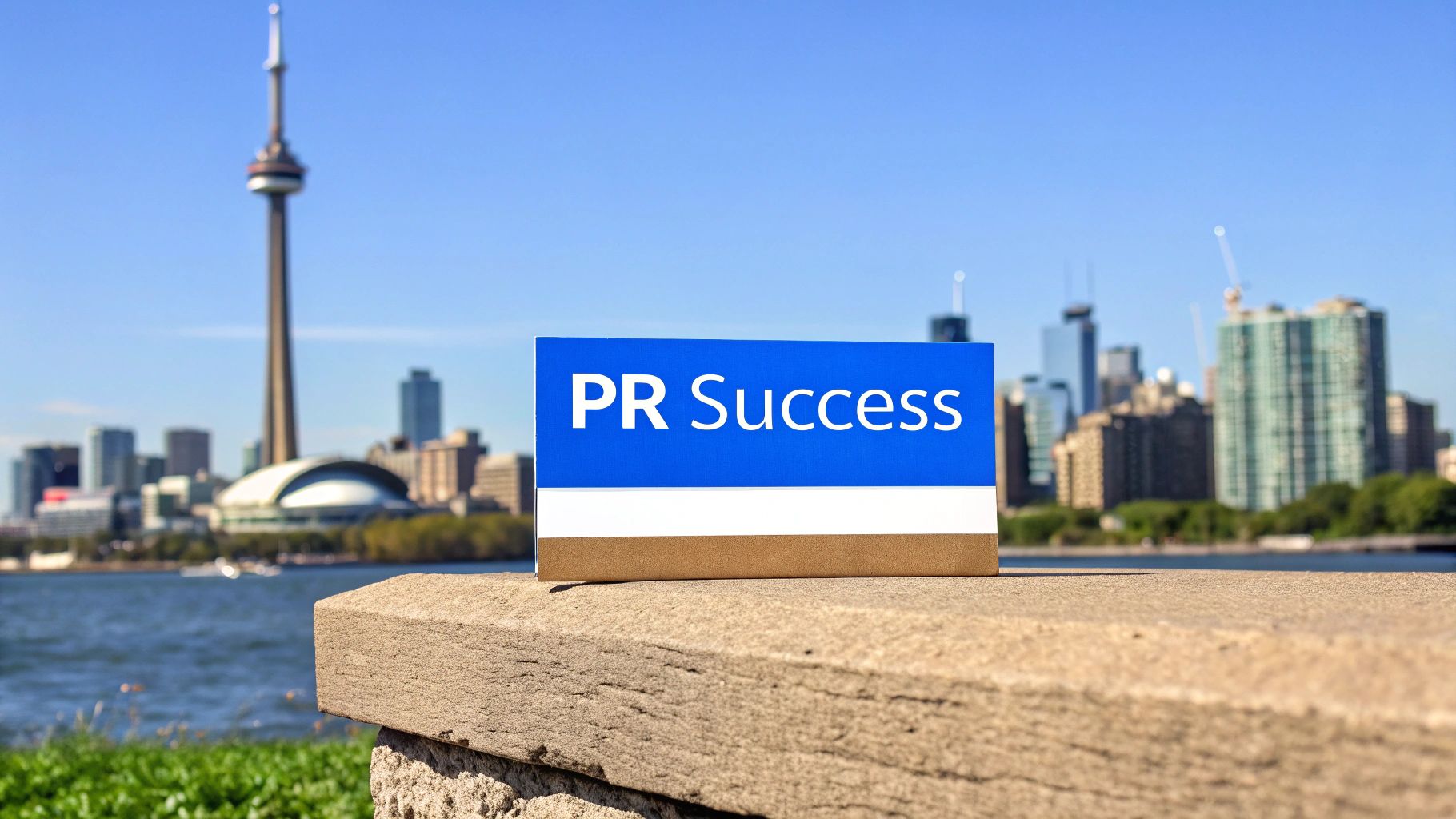Application for PR Canada: Your Success Guide

Navigating Canadian PR Pathways: Your Immigration Roadmap

Applying for permanent residency (PR) in Canada can feel overwhelming. This section clarifies the various pathways available, offering a clearer understanding of the application process. Identifying the program best suited to your individual profile is the first step toward a successful application.
Understanding the Different PR Categories
Canada offers several PR programs, categorized into economic, family sponsorship, and humanitarian streams. Economic programs are designed for skilled workers and professionals who can contribute to Canada’s economy.
These programs include the Federal Skilled Worker Program and the Federal Skilled Trades Program. Family sponsorship allows Canadian citizens and permanent residents to sponsor eligible family members. Humanitarian pathways offer refuge to individuals facing persecution or hardship. Each category has specific eligibility requirements and application procedures.
Exploring Economic Immigration Options
Within economic immigration, the Express Entry system and Provincial Nominee Programs (PNPs) are two primary routes. Express Entry manages applications for three federal programs: the Federal Skilled Worker Program, the Federal Skilled Trades Program, and the Canadian Experience Class.
This system ranks candidates based on factors like education, work experience, language proficiency, and age. It issues Invitations to Apply (ITAs) to top-scoring candidates. PNPs allow provinces and territories to nominate individuals meeting their specific labor market needs. Many PNPs have streams aligned with Express Entry, offering an additional pathway to an ITA.
Canada’s immigration policy is key to its economic and demographic strategy. In 2022, Canada welcomed over 437,000 new permanent residents. This number is projected to reach 485,000 in 2024 and 500,000 in 2025.
This ambitious plan supports economic growth and family reunification. The economic immigration category comprised 58% of all new permanent residents in 2022, highlighting its importance in addressing labor shortages. Learn more about Canada’s immigration policy at What is Canada’s immigration policy?. This growth underscores the need for careful consideration when choosing your PR pathway.
Choosing the right path is crucial. Carefully assess your qualifications, research program requirements, and consider professional guidance to navigate the process effectively.
Cracking the Eligibility Code for PR Application Canada
Securing Permanent Residency (PR) in Canada is a significant goal for many. A successful application hinges on a clear understanding of the eligibility requirements. This section explores the intricacies of a strong PR application, leveraging insights gleaned from experienced immigration consultants who have reviewed thousands of submissions. It’s about moving beyond the surface level and grasping the nuances of each PR pathway.
Decoding the Comprehensive Ranking System (CRS)
The Comprehensive Ranking System (CRS) forms the core of the Express Entry system. It assigns points based on various factors, including age, education, work experience, and language proficiency. However, the weighting of these factors isn’t uniform. Language proficiency and work experience typically carry more weight than age. Therefore, strategically improving your scores in these key areas can significantly enhance your chances of receiving an Invitation to Apply (ITA).
The Impact of Education and Language
Educational credentials are a pivotal component of your CRS score. Holding a Canadian degree or diploma offers a considerable advantage. Foreign credentials also contribute points, especially after receiving an Educational Credential Assessment (ECA). Furthermore, demonstrating strong language proficiency in English or French is paramount. Higher scores on language tests translate to a higher CRS score, bolstering your competitiveness within the applicant pool. Investing in improving your language skills can prove invaluable.
To understand the different program requirements, let’s look at a comparison table.
To help you better understand the specific requirements of each program under Express Entry, the following table summarizes the key criteria for each. This information is crucial for tailoring your application to the most suitable program.
Express Entry Programs Comparison
This table compares the key eligibility requirements for the three Express Entry programs: Federal Skilled Worker Program, Federal Skilled Trades Program, and Canadian Experience Class.
| Program | Education Requirements | Work Experience | Language Requirements | Other Factors |
|---|---|---|---|---|
| Federal Skilled Worker Program | Post-secondary education (Canadian or foreign with ECA) | At least 1 year of continuous full-time (or equivalent part-time) skilled work experience in the past 10 years | Minimum Canadian Language Benchmark (CLB) 7 in all four abilities (reading, writing, listening, and speaking) | Proof of funds, admissibility |
| Federal Skilled Trades Program | Completion of secondary school (high school) | At least 2 years of full-time work experience in a skilled trade in the past 5 years | Minimum CLB 5 for speaking and listening, and CLB 4 for reading and writing | Valid job offer or certificate of qualification in a skilled trade |
| Canadian Experience Class | Post-secondary education (Canadian or foreign with ECA) | At least 1 year of full-time (or equivalent part-time) skilled work experience in Canada in the past 3 years | Minimum CLB 7 for NOC 0 or A jobs, or minimum CLB 5 for NOC B jobs | Admissibility |
As demonstrated above, each program has specific criteria that must be met. Careful review of these criteria will ensure you apply for the program best suited to your qualifications.
Overcoming Eligibility Obstacles
Many PR applicants encounter initial hurdles. These might include gaps in work history, lack of Canadian work experience, or not meeting the minimum language requirements. However, these obstacles are not insurmountable. Strategic planning and focused effort can address these challenges. Acquiring Canadian work experience through a temporary work permit can significantly boost your prospects. Similarly, dedicated language study can raise your scores and pave the way for PR.
Real-World Success Stories
Real-life examples highlight how applicants have overcome eligibility challenges. Consider a Nigerian applicant with a foreign degree and limited work experience. By obtaining an ECA and subsequently a Canadian work permit, they accumulated valuable points and secured an ITA. Another example is an applicant whose initial language scores fell short. Through diligent study and retaking the language test, they achieved a significantly improved score and ultimately attained their PR goal. These success stories underscore the significance of perseverance and strategic planning.
Document Mastery: Building Your Unshakeable PR Application

Your Canadian PR application relies heavily on the documents you submit. They tell the story of your skills, experience, and potential contributions to Canada. This section offers valuable insights into creating a strong document package that not only meets the requirements but also impresses immigration officers.
Understanding The Power of Compelling Documentation
Immigration officers carefully examine each application. A well-organized and complete set of documents shows your commitment and preparation. Think of it as building a case – you need evidence to support your claims. Your documents are that evidence. They validate your story and make it credible.
Tackling Common Documentation Challenges
Many applicants face difficulties with certain document requirements. Securing employment references, for instance, can be challenging, especially if a previous job ended on unfavorable terms. However, addressing these challenges directly is vital. Explain any gaps in employment or inconsistencies in your documentation honestly and transparently.
Credential assessments for foreign degrees and diplomas are often necessary. Ensure you obtain these from designated organizations like World Education Services (WES) to avoid processing delays. Financial documentation is another crucial aspect. Well-organized bank statements and other financial records demonstrate your ability to support yourself and your family in Canada. For an overview of compensation, consider checking the veterans affairs compensation rates 2023.
Learning From Rejection Cases
Examining past rejections offers valuable lessons. Many applications are unsuccessful due to incomplete or inconsistent documentation. A mismatch between claimed work experience and the provided reference letter can be a significant issue. Similarly, insufficient financial proof can lead to rejection.
These cases emphasize the importance of careful attention to detail. Each document should align perfectly with your заявления and satisfy your chosen PR pathway’s specific requirements.
Organizing And Tracking Your Documents
A systematic approach to document management is essential. Create a checklist and track the status of each document. Using a spreadsheet software like Google Sheets or Microsoft Excel or a dedicated document management system is highly recommended. This ensures you have everything ready and avoids last-minute stress.
A proactive approach also allows you to respond quickly to any additional requests from immigration officers. This organized strategy demonstrates your commitment to a smooth application process, improving your chances of success.
To assist you further, we’ve compiled a checklist of essential documents:
Essential Documents Checklist for PR Application
A comprehensive checklist of required documents for different permanent residency application streams in Canada
| Document Type | Required For | Validity Period | Special Requirements |
|---|---|---|---|
| Passport | All streams | Must be valid | Biometric page required |
| Birth Certificate | All streams | No expiry | Must be translated if not in English or French |
| Educational Credentials | All streams | N/A | May require Educational Credential Assessment (ECA) |
| Language Test Results (IELTS, CELPIP) | Most streams | 2 years | Minimum scores vary by stream |
| Police Clearance Certificate | All streams | Varies by country | Required for all countries where you’ve lived for 6+ months |
| Proof of Funds | Most streams | Varies | Must demonstrate sufficient funds to support yourself and your family |
| Medical Examination | All streams | 1 year | Completed by an approved panel physician |
| Photographs | All streams | N/A | Specific size and format requirements |
| Employment References | Most streams | N/A | Should detail roles, responsibilities, and duration of employment |
This table summarizes the key documents required for most Canadian PR applications. Be sure to consult the specific requirements for your chosen immigration program.
The Importance of a Strong Application
Statistics Canada emphasizes immigration’s growing role in Canada’s population, projecting that immigrants will represent 29.1% to 34.0% of the population by 2041. This growth, especially in urban areas, reflects Canada’s commitment to diversity. Ontario, for example, attracted roughly 44% of new permanent residents between 2016 and 2021. Find more detailed statistics here. This data highlights the competitive landscape and underscores the need for a well-prepared application. Remember, your PR application represents a significant investment. Thorough document preparation greatly improves your prospects of a positive outcome.
Application for PR Canada: The Insider’s Process Guide

A well-structured application is key to a successful Permanent Resident approval. This section provides a step-by-step guide, from profile creation to final submission, drawing on insights from immigration professionals and recently approved residents.
Navigating the IRCC Portal
The Immigration, Refugees and Citizenship Canada (IRCC) portal is your main tool throughout the application process. Creating an account and learning to navigate it efficiently are the first steps. While many find the portal complex, it becomes manageable with practice.
Save your login details securely and familiarize yourself with the different sections. A strong, unique password is essential to protect your sensitive data. These initial steps lay the groundwork for a smoother experience.
Biometrics, Medicals, and Background Checks
After submitting your application, you’ll need to complete biometrics, medical examinations, and background checks. Schedule these appointments promptly, as delays can affect processing times. Successful applicants often book in advance to avoid scheduling conflicts.
Be sure to bring all necessary documents, including your passport and appointment confirmation. This preparation ensures a streamlined process and minimizes hold-ups.
Monitoring Your Application and Responding to Requests
Actively monitor your application’s status through your IRCC portal account. Understanding typical processing times for your program helps manage expectations. While the IRCC website provides estimated processing times, regular monitoring is vital, as these can vary.
The IRCC may request further documents. Respond promptly and thoroughly to these requests, providing clear explanations and supporting evidence. This demonstrates your commitment and can expedite the process.
Practical Timelines and Strategies
While precise timelines are impossible to guarantee, realistic expectations are essential. The IRCC website provides current processing times for various programs, offering a helpful benchmark.
Remember, these are estimates, and individual cases may differ. This understanding allows for better preparation and expectation management during the waiting period.
Responding to Additional Document Requests
A request for more documents can seem concerning, but it’s a common part of the process and doesn’t necessarily signal a problem. View it as a chance to strengthen your application.
Organize the requested materials meticulously, providing clear explanations where needed. This reassures the immigration officer and showcases your commitment to accuracy.
From Submission to Decision: Maintaining Momentum
The period from submission to decision demands patience and persistence. Stay organized, keep your records current, and stay informed about any policy or procedural changes.
Consider consulting experienced immigration professionals if you encounter challenges or have questions. Their expertise can be invaluable during this stage, offering support and guidance. A proactive, informed approach maximizes your chances of realizing your Canadian PR aspirations.
Provincial Pathways: Unlocking Regional PR Opportunities
While many focus on Express Entry, Provincial Nominee Programs (PNPs) can be a more accessible route to Canadian Permanent Residency (PR), particularly for those from Nigeria. This section explores how PNPs can drastically improve your PR prospects.
Understanding the Power of PNPs
PNPs allow provinces and territories to nominate individuals who meet their specific labor market needs. This means provinces can select candidates with in-demand skills and experience. For example, a province might prioritize healthcare workers or IT professionals.
This targeted approach often results in faster processing times and higher success rates.
Matching Your Profile to the Right Province
Each province has unique selection criteria and streams within its PNP. Researching these is key to a successful application. Some provinces, like Ontario and British Columbia, have larger programs with various streams. Others, like Prince Edward Island and Manitoba, focus on specific industries or communities. Understanding these regional priorities is crucial for your PR application to Canada.
Exploring Lesser-Known Opportunities
Beyond the popular provinces, some PNPs offer less competition and faster processing. For example, the Atlantic Immigration Pilot Program targets skilled workers and international graduates wanting to settle in Atlantic Canada.
Additionally, some provinces have streams specifically for entrepreneurs or those with family ties in the region. These niche programs could be your fast track to PR.
Base vs. Express Entry-Aligned PNPs: What’s the Difference?
PNPs generally fall into two categories: base and Express Entry-aligned. Base PNPs involve a separate application process directly to the province. Express Entry-aligned streams allow you to be nominated through the Express Entry system.
This can significantly increase your Comprehensive Ranking System (CRS) score, potentially guaranteeing an Invitation to Apply (ITA) for PR. Understanding this difference is essential for a successful application.
Real-World Success with PNPs
Many applicants from Nigeria have found success through strategic PNP applications. One example is a Nigerian nurse who struggled to obtain sufficient points through Express Entry. By applying to a PNP in Saskatchewan with a specific stream for healthcare workers, she received a provincial nomination and subsequently her PR.
Another applicant, an engineer from Lagos, was initially rejected through Express Entry. By applying through the Nova Scotia PNP, which aligned with his occupation, he was nominated and granted PR. These stories demonstrate the power of pursuing regional opportunities to achieve your Canadian immigration goals.
PR Application Pitfalls: Learning From Others’ Mistakes
Even the most qualified candidates can encounter setbacks in their Canadian PR application process. This section explores common, often subtle, mistakes that can derail an application, drawing on insights from experienced immigration consultants.
Inconsistencies: A Red Flag For Immigration Officers
One of the most frequent errors is inconsistency between the information provided in the application and the supporting documents. Immigration officers conduct thorough reviews, and any discrepancy, such as a mismatch between claimed work experience and reference letters, raises immediate red flags. This can cast doubt on an applicant’s credibility and ultimately lead to rejection.
Misinterpreting Financial Requirements: A Preventable Rejection
Another common pitfall involves misinterpreting the financial requirements. Each program has specific criteria regarding Proof of Funds. Some applicants mistakenly focus only on initial settlement funds, overlooking ongoing living expenses. Others submit insufficient documentation or outdated bank statements. Careful attention to these financial details is crucial for application success.
Credibility Concerns and Future Immigration Attempts
Errors, especially those perceived as misrepresentation or omission of information, can have long-term consequences. Credibility concerns arising from one application can impact future immigration attempts. For example, exaggerating work experience could lead to rejection and a negative mark on an applicant’s record, hindering future visa applications. Honesty and accuracy are paramount throughout the entire process.
Verification Techniques and Recovery Strategies
Successful applicants often employ verification techniques to minimize errors. They meticulously review every document, ensuring consistency across all submitted materials. Seeking guidance from immigration professionals, such as those at JapaChat, can help ensure accurate understanding and fulfillment of program requirements. If setbacks do occur, recovery strategies exist. Addressing previous errors, providing additional documentation, or exploring appeal options can be viable solutions.
The Importance of Accuracy and Transparency
Accuracy and transparency are essential for a successful Canadian PR application. This involves being truthful about your background, qualifications, and intentions. It also requires providing comprehensive and accurate supporting documentation. While embellishing or omitting details might seem tempting, such actions can jeopardize the entire application. The Canadian immigration system places a high value on honesty and integrity.
Ready to navigate your Canadian immigration journey with confidence? JapaChat, Nigeria’s leading AI immigration expert platform, offers personalized guidance and support. From visa requirements to document preparation, JapaChat provides up-to-date information and practical tools. Sign up for free today at JapaChat and begin your relocation journey with greater clarity and assurance.
Comments
2 responses to “Application for PR Canada: Your Success Guide”
-
[…] For instance, experience in a high-demand occupation in Canada, such as IT or healthcare, can boost your points. This demonstrates the value of aligning your skills with Canadian needs. Read also: How to master your Canadian PR Application. […]
-
[…] Community Connections: Begin connecting with the Manitoba community before you arrive. Engaging with local organizations and groups can build a support network and facilitate a more seamless integration into your new surroundings. You might be interested in researching resources like Applying for PR in Canada. […]

Leave a Reply